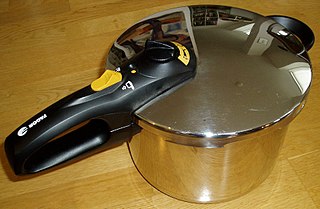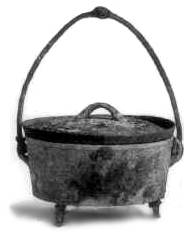
A kitchen is a room or part of a room used for cooking and food preparation in a dwelling or in a commercial establishment. A modern middle-class residential kitchen is typically equipped with a stove, a sink with hot and cold running water, a refrigerator, and worktops and kitchen cabinets arranged according to a modular design. Many households have a microwave oven, a dishwasher, and other electric appliances. The main functions of a kitchen are to store, prepare and cook food. The room or area may also be used for dining, entertaining and laundry. The design and construction of kitchens is a huge market all over the world.

Grilling is a form of cooking that involves dry heat applied to the surface of food, commonly from above, below or from the side. Grilling usually involves a significant amount of direct, radiant heat, and tends to be used for cooking meat and vegetables quickly. Food to be grilled is cooked on a grill, using a cast iron/frying pan, or a grill pan.

Pressure cooking is the process of cooking food under high pressure steam, employing water or a water-based cooking liquid, in a sealed vessel known as a pressure cooker. High pressure limits boiling, and permits cooking temperatures well above 100 °C (212 °F) to be reached.

Roasting is a cooking method that uses dry heat where hot air covers the food, cooking it evenly on all sides with temperatures of at least 150 °C (300 °F) from an open flame, oven, or other heat source. Roasting can enhance the flavor through caramelization and Maillard browning on the surface of the food. Roasting uses indirect, diffused heat, and is suitable for slower cooking of meat in a larger, whole piece. Meats and most root and bulb vegetables can be roasted. Any piece of meat, especially red meat, that has been cooked in this fashion is called a roast. Meats and vegetables prepared in this way are described as "roasted", e.g., roasted chicken or roasted squash.

Cookware and bakeware are food preparation vessels used in kitchens. Cookware is used on a stove or range cooktop, while bakeware is used in an oven. Some utensils are considered both cookware and bakeware.

Outdoor cooking differs substantially from kitchen-based cooking, the most obvious difference being lack of an easily defined kitchen area. As a result, campers and backpackers have developed a significant body of techniques and specialized equipment for preparing food in outdoors environments. Such techniques have traditionally been associated with nomadic cultures such as the Berbers of North Africa, the Arab Bedouins, the Plains Indians, pioneers in North America, and indigenous tribes in South America. These methods have been refined in modern times for use during recreational outdoors pursuits.

A Dutch oven is a thick-walled cooking pot with a tight-fitting lid. Dutch ovens are usually made of seasoned cast iron; however, some Dutch ovens are instead made of cast aluminium, or ceramic. Some metal varieties are enameled rather than being seasoned, and these are sometimes called French ovens. Dutch ovens have been used as cooking vessels for hundreds of years. They are called casserole dishes in English-speaking countries other than the United States, and cocottes in French. They are similar to both the Japanese tetsunabe and the sač, a traditional Balkan cast-iron oven, and are related to the South African potjiekos, the Australian Bedourie oven and Spanish cazuela.
Trammel or Trammelsor Trammell may refer to:

A slow cooker, also known as a crock-pot, is a countertop electrical cooking appliance used to simmer at a lower temperature than other cooking methods, such as baking, boiling, and frying. This facilitates unattended cooking for many hours of dishes that would otherwise be boiled: pot roast, soups, stews and other dishes.
The Japanese kitchen is the place where food is prepared in a Japanese house. Until the Meiji era, a kitchen was also called kamado and there are many sayings in the Japanese language that involve kamado as it was considered the symbol of a house. The term could even be used to mean "family" or "household". Separating a family was called kamado wo wakeru, or "divide the stove". Kamado wo yaburu means that the family was broken.

Irish stew is a lamb or mutton and root vegetable stew native to Ireland. As in all traditional folk dishes, the exact recipe is not consistent from time to time, or place to place. Basic ingredients include lamb, or mutton, as well as potatoes, onions, and parsley. It may sometimes also include carrots. Irish stew is also made with kid goat.
Irish stew is a celebrated Irish dish, yet its composition is a matter of dispute. Purists maintain that the only acceptable and traditional ingredients are neck mutton chops or kid, potatoes, onions, and water. Others would add such items as carrots, turnips and pearl barley; but the purists maintain that they spoil the true flavour of the dish. The ingredients are boiled and simmered slowly for up to two hours. Mutton was the dominant ingredient because the economic importance of sheep lay in their wool and milk produce and this ensured that only old or economically non-viable animals ended up in the cooking pot, where they needed hours of slow cooking. Irish stew is the product of a culinary tradition that relied almost exclusively on cooking over an open fire. It seems that Irish stew was recognised as early as about 1800.

Induction cooking is performed using direct induction heating of cooking vessels, rather than relying on indirect radiation, convection, or thermal conduction. Induction cooking allows high power and very rapid increases in temperature to be achieved, and changes in heat settings are instantaneous.

A solar cooker is a device which uses the energy of direct sunlight to heat, cook or pasteurize drink and other food materials. Many solar cookers currently in use are relatively inexpensive, low-tech devices, although some are as powerful or as expensive as traditional stoves, and advanced, large-scale solar cookers can cook for hundreds of people. Because they use no fuel and cost nothing to operate, many nonprofit organizations are promoting their use worldwide in order to help reduce fuel costs and air pollution, and to help slow down deforestation and desertification.
A pothook is an S-shaped metal hook for suspending a pot over a fire.

Heavy-duty cookware made of cast iron is valued for its heat retention, durability, ability to be used at very high temperatures, and non-stick cooking when properly seasoned. Seasoning is also used to protect bare cast iron from rust. Types of cast iron cookware include frying pans, dutch ovens, griddles, waffle irons, flattop grills, panini presses, crepe makers, deep fryers, tetsubin, woks, potjies, and karahi.

A handi is a cooking basin made from copper or clay (pot), which calls the Indian subcontinent home. It is utilised primarily in north Indian, Pakistani and Bangladeshi cooking.

A pot rack is a functional piece of kitchen furniture that is used to hang or store cooking pots and pans. Steel, wood, wrought iron, and a few other metals are the most common types of materials used for pot racks. Pot racks also usually have some type of finish or stain to help them match pots and decor. In addition, pot racks can range in size from less than a foot to over fifteen feet long. These larger pot racks are capable of supporting dozens of pots and pans.

A kitchen utensil is a small hand held tool used for food preparation. Common kitchen tasks include cutting food items to size, heating food on an open fire or on a stove, baking, grinding, mixing, blending, and measuring; different utensils are made for each task. A general purpose utensil such as a chef's knife may be used for a variety of foods; other kitchen utensils are highly specialized and may be used only in connection with preparation of a particular type of food, such as an egg separator or an apple corer. Some specialized utensils are used when an operation is to be repeated many times, or when the cook has limited dexterity or mobility. The number of utensils in a household kitchen varies with time and the style of cooking.

Scorched rice, also known as crunchy rice, is a thin crust of slightly browned rice at the bottom of the cooking pot. It is produced during the cooking of rice over direct heat from a flame.

A kazan or qazan is a type of large cooking pot used throughout Central Asia, Azerbaijan, Turkey, and the Balkan Peninsula, roughly equivalent to a cauldron, boiler, or Dutch oven. They come in a variety of sizes, and are often measured by their capacity, such as "a 50-litre kazan". Usually their diameter is half a meter. Kazans are made of cast iron or in modern times aluminum and are used to cook a wide variety of foods, including plov (pilaf), sumalak, shorpa, kesme, and bawyrsaq, and as such are an important element in celebrations when food must be prepared for large numbers of guests.


















